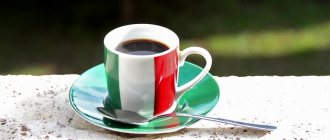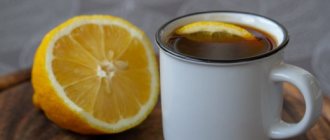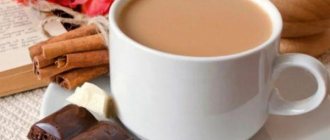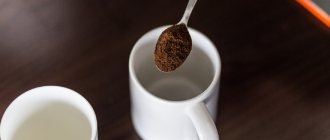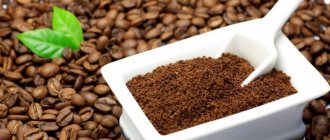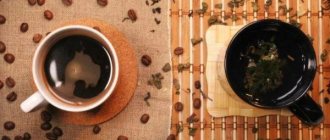Coffee cannot be classified as a regular drink, although it is consumed in most countries. But, as they say, as many countries as there are so many cooking methods. Recipes vary depending on local conditions and technical capabilities. Today, the most common are about a dozen ways to prepare the drink.
To make coffee right and tasty, you need a person who can do it. The barista, or literally the person working behind the bar, is this specialist. But, strictly speaking, this bartender’s narrow specialization is espresso.
This drink is very popular in many countries
Coffee must not only be prepared correctly, but also served correctly to visitors. Each barista has his own secrets and little tricks that turn him into a real master.
In everyday life, we are faced with the main options for obtaining a coffee drink. We have mastered some of them quite well.
Making coffee in Turkish
Most likely, the most ancient method of making a fragrant drink is coffee brewed in a Turk, otherwise called a cezve. It is also called “Turkish coffee”.
To prepare it, you need to know in advance how many people you need to treat. Based on this, the size of the Turks is selected, and this is important. The taste and aroma may change if you cook only three in a Turk for four servings.
For a serving, take one teaspoon of coffee, which has been ground to a dust state. Fill with water (preferably spring water) and cook over low heat until the foam begins to rise. Then the Turk is quickly removed from the heat, and the foam is gently collected and placed into cups. After this procedure, the Turk is put back on the fire and the drink is heated. The boiling procedure can be repeated up to 6 times, at the discretion of the master. If you need sweet coffee, then it is better to put sugar in the cezve first. Do the same with spices.
Important: A particularly rich taste and indescribable aroma is obtained if the Turk is heated with hot sand.
The classic version of cooking “Turkish” - on hot sand
Classic coffee with cinnamon
Ingredients:
- 1 tsp. ground natural coffee;
- 125 ml water;
- 1/3 tsp. cinnamon;
- 1/3 tsp. Sahara.
Cooking method:
- Initially, we heat the ingredients “dry” and only after that add a cup of water.
- This is worth talking about in more detail.
- If you want to drink delicious coffee, make sure it is drinking, clean water.
- Do not take it directly from the tap; there is not a word in the recipe about the need to add bleach or iron oxides to the drink.
- How much water to add
- One cup, since this amount of coffee, sugar and cinnamon is for one serving.
- Set that 0.7-liter cup with a charming and witty inscription, donated by colleagues, aside.
- This meant a real coffee cup, miniature and elegant.
- Churchill was right when he argued that such a personal drink as coffee cannot be drunk in mugs, just as good cognac cannot be drunk in mugs.
- After adding water, heat the Turk and watch the process with a vigilant eye.
- You can write gigabytes of text about the ability of coffee that has just pretended to be almost cold to instantly boil and splash out onto the stove.
- When the coffee begins to boil, pour a small portion into the cup you have prepared for the divine drink.
- We repeat the operation, moving the entire volume of the drink from the Turkish cup into the cup 3-4 times.
- As a result, you will get gorgeous coffee with aromatic and tasty foam.
- For those who prefer a milder taste, this is suitable.
Bon appetit!
Preparing a drink in a coffee pot
This technology method is also simple. Its main value lies in the possibility of obtaining a large volume of product. So:
- Put the coffee pot with water on the fire.
- Warm up the cups.
- Before the water boils, remove the coffee pot and pour coarse or medium ground coffee into it and stir.
- You need to wait a few minutes.
- Pour the resulting drink using a fine strainer.
The coffee pot cannot be used for other drinks. And keeping it properly clean will also not be unnecessary.
French press - convenient and beautiful
One of the simple, but very aesthetic methods of cooking is in a French press. This method is suitable for restaurants and coffee shops that have coffee cards and serve single-origin coffee (this is coffee whose beans are collected exclusively from one territory and during one period).
Video on the topic
Making coffee using a French press
Click Play to view
At home, this technology has many advantages:
- You can brew any type of coffee in a French press.
- Spices are added at the same time as coffee powder.
- The drink is brewed very carefully.
- This convenient method reveals the taste of the drink most fully.
You might be interested in Thai coffee recipe
There are other advantages of this method. But you need to understand that coffee made using a French press is not espresso. This is a completely special, different drink. And you need to get used to this.
Types of coffee and their differences. How do different types of coffee differ?
What types of coffee are there and how are they different? The most popular variety is Arabica . This long-discovered type of grain is used everywhere now. Coffee trees grow in the hot climates of the highlands. Each species requires special environmental conditions for growing grains of a certain variety and taste.
The softness and tenderness of the drink's texture is provided by the oils contained in the grains. The taste depends on the conditions in which the trees grow, on the climate and weather, so the quality of the drink may vary within one type.
Another commonly used type of grain is Robusta . They contain more amino acids, caffeine, and have a strong bitterness, which is removed by processing. Robusta is not consumed in its pure form, but is added to other varieties for strength. Due to the unpretentiousness of the trees, grains can be grown in almost any conditions. The ease of cultivation justifies the low cost of Robusta. It is usually added to Arabica beans to reduce the price.
Filter coffee maker - brewing coffee for busy people
This process is not complicated. The grains are ground and the powder is placed in a filter made of paper. Water flows through this filter for several minutes.
The finished drink accumulates in a container that doubles as a thermos. The more powder in the filter, the stronger the drink, however, the consumption of powder per cup with this method is much greater. But this depends on the model of your coffee maker.
The main advantage of this method is its automation. The process occurs without your constant control, but you get a lot of drink, and it is stored for some time in a thermos, and without sediment.
You can quickly brew coffee at home using a filter coffee maker.
Geyser coffee maker - a method originally from France
The first analogues of such devices appeared about two hundred years ago, in France. But the design has since been improved, acquiring a modern look.
Video on the topic
Making coffee in a geyser coffee maker
Click Play to view
In its current version it has three compartments. One contains coarsely ground coffee, the other contains water, and the third compartment is for the finished product. Coffee here is prepared by boiling water. In such a coffee maker, water is passed through the poured coffee once. And according to the type of heating, the device can operate from electricity or another heat source.
Classic Irish coffee recipe
Ingredients:
- water – 100 ml,
- whiskey – 30 ml (2 tablespoons, at the rate of 1 tablespoon holds 15 ml),
- coffee beans - 4-5 teaspoons,
- granulated sugar – 1 teaspoon,
- whipped cream – 30-40 ml,
- drinking cream 20% - 5-6 teaspoons (for those who do not like whipped cream).
Cooking steps:
- First of all, we prepare coffee.
- In a coffee grinder, carefully grind 4 teaspoons of coffee beans until dusty.
Espresso - coffee brewed by machine
This method is called the most technology-dependent. To get good espresso, you need to pass hot water with a pressure of 9 - 15 atmospheres through compressed coffee. The powder is taken very finely ground.
Special taste sensations are achieved through rapid, complete extraction of the product. Since a serving of real espresso has a certain volume, almost all machines are designed for exactly this dosage - 30-35 ml.
Freshly prepared espresso is viscous, like syrup. It should also be decorated with persistent, golden-colored foam - crema. The quality of these attributes determines the qualifications of a barista.
Good espresso is obtained from specially developed blends of several varieties. If their combination is chosen correctly, then the final result is ideal. Naturally, a small portion will cool down earlier, so special cups with thick walls must be heated.
It is believed that a fully automatic machine prepares a drink worse than a carob machine. But it's all about the settings. If they are set correctly, the drink will turn out fabulously aromatic. What is also important is the ability of the barista to thoroughly know the settings of the coffee machine and constantly adjust them. Well, the high cost directly depends on the cost of this machine and the raw materials themselves.
Espresso is brewed in special automatic coffee makers
Cappuccino - the heritage of the monks
The Capuchins, monks of an Italian monastery, once noticed that adding milk to coffee creates a dense, tasty foam. And a certain self-taught Giuseppe, who lived next to the monastery, built a machine for making cappuccino. We still use his invention, improved and automated.
Essentially, the basis of this process is producing milk foam using steam. And everything else is no longer difficult. Place the prepared foam into a cup where espresso has already been added, and get a white cappuccino. And if you pour coffee into a cup where foam has previously been placed, the cappuccino will turn out black.
If you really want to try a magic drink, but don’t have a miracle machine at hand, don’t despair. We brew coffee in the Turk until the foam rises, and, without allowing it to boil, we lift the Turk and put it back. We do this procedure 7 - 8 times.
You may be interested in How to brew the “right coffee” at home - advice from a professional barista
Now you need to prepare the foam. Pour milk or cream (for one cup) into a metal mug and place it on the stove. After 10 seconds, turn on the mixer and beat the milk. When the large bubbles disappear, remove the mug from the heat. Gently transfer the foam onto the coffee surface. You can savor it!
It's easy to check the quality of cappuccino. A spoonful of sugar is poured onto the foam, and the sugar should remain on the surface. One of the secrets to a delicious cappuccino is the original espresso. It must be very well prepared from high quality grains.
Basic cooking methods:
Coffee in Turkish or Eastern style
This method of making coffee is the first of the first. It was with the help of the Turka (cezve or ibrik) that the first coffee was prepared, or rather, the first drink that vaguely resembled modern coffee. Since Soviet times, it has been the custom that coffee needs to be prepared in a huge pot on gas. This is a bit of a wrong decision, since oriental coffee is prepared on hot sand - this is very important. In addition, the cezve itself should be made of copper (lined on the inside with tin or silver - copper is slightly toxic), since this metal has ideal parameters for making coffee: it heats up evenly and quickly transfers heat throughout the entire vessel.
The shape of the cezve also turned out this way for a reason - the coffee foam forms a plug on the surface, which helps the drink to brew. The rest of the cooking process is as follows:
- Amount of coffee: 7-9 g/60 ml;
- Grinding: to dust, the finest;
- Water temperature: 60 oC;
- Extraction time: 2-3 strokes of foam without bringing to a boil.
Preparation:
- pour 7-9 grams of coffee into the pot, add sugar and spices if necessary;
- pour water at a temperature of 60°C and mix thoroughly;
- place the Turk in hot sand or place it on the stove. If sand is used, the Turk must be constantly moved in a circle so that it heats up evenly;
- as soon as the foam begins to rise, you must immediately raise the Turk and wait until the foam settles;
- repeat the process 2-3 more times, depending on the desired strength of the drink;
- pour the prepared aromatic coffee into a cup and wait until the grounds settle.
French press (kafetner) or piston method
The French press is a method of preparing coffee for true coffee connoisseurs. It is coffee that is prepared using the piston method that is used to prepare Irish coffee and other classic coffee drinks. In addition, French press coffee participates in cap-tester competitions (determination of flavor shades in a particular coffee). For this cooking method, the coarsest grind is used. The tools used are a coffee pot and a piston with a filter (these are sold in any tea store).
Not everyone will like French press coffee, as it has a weak taste, at least for inexperienced coffee drinkers. For this method, it is better to use single-origin coffee, not mixtures, for example, Ethiopia Yergachef, Sidamo, Pacamara, etc.
- Coffee quantity: 8 g/100 ml
- Grinding: coarse, coarse
- Water temperature: 90-96 oC
- Extraction time: 3-5 min
Preparation:
- preheat the flask (pour hot water into it and then drain);
- pour coffee and water;
- cover with a plunger lid and wait until the drink brews (freshly roasted coffee usually foams a lot - a great way to check);
- then you need to slowly lower the piston down to the limit, separating the coffee grounds;
- pour coffee into cups.
Aero press
This is the youngest method of making coffee. In principle, in terms of taste, coffee prepared in an aero press is not much different from coffee from a French press. But this is only at first glance. Its taste is richer, softer, in general, what you need. Recently, aero presses have become very often used in barista competitions instead of French presses. Aero press - two flasks, on one of which a cap with a filter is put on, which also serves as a supporting part inserted into the cup. The second flask is equipped with a rubber gasket and fits very tightly on top of the first flask. Thus, the second flask squeezes the finished drink into the cup with air (hence “aero”).
- Amount of coffee: 20 g/200 ml;
- Grind: espresso grind;
- Water temperature: 80-95 oC;
- Extraction time: 30 sec.
Preparation:
- a paper filter is placed in the lid, which is screwed to the base of the first vessel;
- the first vessel is turned over with the lid down and inserted into a cup or other container;
- Ground coffee is poured into it and water is poured in, after which the contents are thoroughly mixed;
- A second piston vessel is placed on top of the first vessel, and it forces coffee into the cup (for 25-30 seconds, espresso extraction time).
Filter method or drip method
This is perhaps the most familiar and one of the most popular methods of making coffee in the world. It is more common in the West, particularly in the USA. The idea is simple: coffee is poured into the filter, where a thin stream (drops) of water is then constantly fed, which gradually washes out all the components from the ground coffee. Everyone has seen such things in films: Americans have glass teapots with ready-made coffee. In fact, this is what they call coffee in American style. Another feature: the so-called American roast is best suited for this method - light (European - medium, Italian - strong).
- Amount of coffee: 12 g/200 ml;
- Grind: medium;
- Water temperature: 90-96 oC;
- Extraction time: 3-5 min. depending on the amount of coffee poured in and the degree of grinding.
Preparation:
- coffee is poured into the upper part of the coffee maker into a paper filter;
- then water is supplied there, which gradually flows through the coffee and fills the kettle (in some models of coffee makers, water is supplied automatically);
- Then we wait until the required amount of drink is prepared;
- Modern coffee makers have a heated bottom that keeps the coffee hot all the time.
Espresso
Now I've come to the most interesting part. Now I will only scratch the surface of the process of making coffee in an espresso machine. We are talking specifically about professional equipment, and not about home equipment, where you don’t need to do anything. To be honest, you won’t be able to do anything meaningful with home appliances, so it’s better to drink espresso in a coffee shop, and prepare home-made coffee in a Turk, using the drip method, in a French or aero press. The essence of espresso is simple: there is a coffee machine that can push water through a “tablet” of ground coffee under pressure. The process is quite complicated, so I won’t describe it here, but will prepare a separate post.
Latte - for milk lovers
Latte macchiato consists of three layers. Translated from Italian it will sound like “stained milk.” In essence, it is a cocktail consisting of layers of espresso, hot milk and foam. The correct technology for making latte macchiato is as follows. Milk is poured into a cup, or better yet a transparent glass. After this, espresso is poured into it in a thin stream. The main thing here is not to mix the layers. There is foam on top. The best option is when hot coffee pours through the delicate foam at the very last moment. The latte is simply prepared in a different order - the milk is carefully poured over the coffee. And this drink has a more pronounced taste of coffee, unlike latte macchiato.
Latte is coffee with a lot of milk
Types of ready-made coffee (without milk)
For the average consumer, not only varieties are important, but also various variations of cooking methods. There are a huge variety of them, anyone can choose something to their liking. When preparing coffee, it is important to maintain proportions.
Most cooking methods are of Italian or European origin, although the traditional method has Eastern roots.
Espresso and types of drinks prepared on its basis:
1. Espresso . The standard serving size is 35 grams. It is usually prepared by mixing Robusta and Arabica beans to give it a stronger taste. The light brown color of the crema indicates that you are drinking real espresso.
2. Doppio . This name, unfamiliar to many, has a recipe for the most common double espresso.
3. Viennese coffee . Regular strong coffee with a huge layer of whipped cream that feels like a delicate sweet cloud. Sprinkled with chocolate, nuts, and spices used in baking.
4. Romano . It has a special Roman appearance, the distinctive feature of which is sourness. Romano is decorated and contains a slice of lemon, which gives it an unusual taste.
5. Ristretto . Its volume is very small, but it contains more caffeine than any other drink. For Ristretto, the same ingredients are used, but several times less water is added. This makes the coffee stronger and thicker.
6. Americano - espresso diluted with water after preparation.
7. Lungo . The amount of traditional espresso is doubled due to the addition of water directly during preparation.
8. Macchiato . Regular espresso with the addition of a spoonful of milk foam, which does not need to be stirred.
9. Kon pana . Garnished with whipped cream and sprinkled with cinnamon, this type of coffee can be stirred.
10. Coretto . Alcohol is added to the prepared base. Drink with honey or cane sugar.
11. Irish . Alcohol and cream are added with various doping agents.
12. Glasse .
Refers to cold drinks suitable for summer. It is based on a traditional strong chilled espresso and a scoop of chocolate chip ice cream.
Flavored coffee - a drink for everyone
If you want to get something unusual from your favorite drink, add something extraneous to it. The main thing is that it is aromatic and edible. There are two ways to achieve the desired effect.
- First option. You need to take some flavoring (vanilla, cinnamon) and add it to freshly roasted coffee. By using this method, you will gain confidence in the quality of the source material.
- Second option. We buy a ready-made product, industrially flavored. It will have a delicate aroma, but the quality of the resulting drink is unlikely to be high. To produce such coffee, beans are usually not the best varieties, because the flavoring will still overwhelm the coffee aroma.
If you want to have a high-quality drink, you should not buy ready-made flavored mixtures. Don't be lazy to prepare them yourself.

